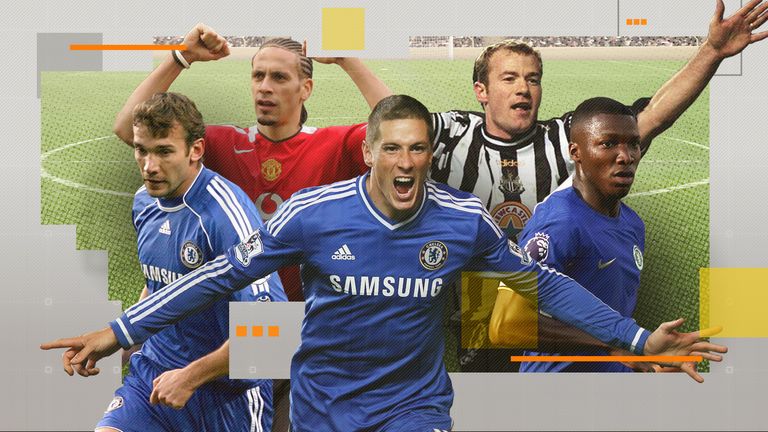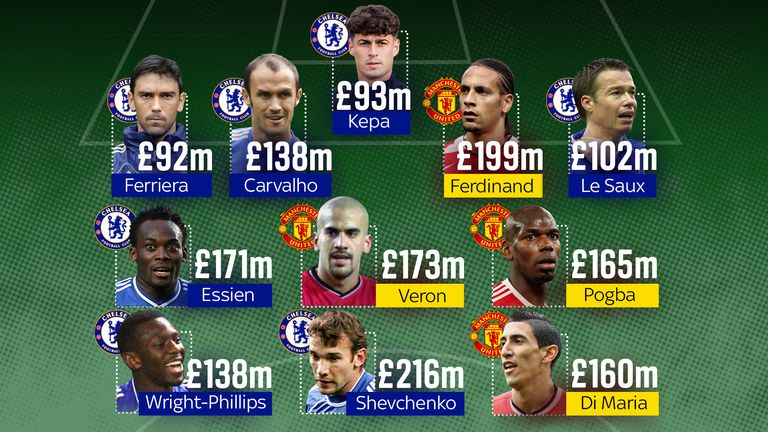Who's really the most expensive ever Premier League transfer?
Moises Caicedo's £115m move from Brighton to Chelsea this summer broke the British transfer record, but it's not even in the top 30 if we adjust for "football inflation". Sky analysis shows who has the "real" transfer record, and which club and managers have spent the most.
Wednesday 30 August 2023 15:33, UK
The British transfer record has been broken twice this year already - and four times in the last two years.
And with two days left before the transfer window slams shut, who's to say it won't be broken again?
While £100m+ transfers are a new phenomenon, if we adjust for inflation the most expensive Premier League player of all time has been the same for almost 20 years.
Ukrainian striker and favourite of former-Chelsea owner Roman Abramovich, Andriy Shevchenko comes out on top.
His £31m transfer to Chelsea from AC Milan in 2006 was almost ten times more than the average player at the time. That average has gone up to more than £20m, so his transfer would be worth £215m today.
We haven't included 2023/24 transfers in our calculations as we don't have a full season's worth yet, but the average fee so far this season is more than £30m.
Rio Ferdinand comes in second place and by far the most expensive defender on the list - his £29m fee in 2002 is equivalent to £199m today, data analysis from Sky News and Sky Sports News reveals.
Three strikers - Fernando Torres, Alan Shearer and Wayne Rooney - complete the top five.
Chelsea's new record signing, Moises Caicedo, signed for £115m from Brighton this summer, wouldn't even make the top 30.
Here's how our newly calculated top ten really looks - click on the column headers to filter by club or season, or search for specific players or teams you're interested in.
Keep up to date with all the latest news and rumours on Transfer Deadline Day with Sky Sports News' free streams on the final day of the window.
Most expensive Premier League XI
Seven players in the most expensive all-time Premier League starting line-up are Chelsea signings - many from the early Abramovich era in the mid-2000s - with the remaining four all Manchester United players.
Manchester City are the only other club whose signings would even make the substitutes bench, picking players in appropriate positions to have a balanced match-day squad.
City signings Joleon Lescott, Kevin de Bruyne and Robinho are among the most expensive signings in their positions after adjusting for inflation.
Man United's Nani, Jaap Stam, Michael Carrick, David de Gea and Luke Shaw - the only current Premier League player in the "squad" - would also make the bench, alongside Chelsea's Fernando Torres.
Which clubs have spent most?
Taking into account how much footballers were worth each season, Chelsea are the biggest overall spenders of the Premier League era.
Their spending in 2003-04 and 2004-05 - the first two full seasons under Mr Abramovich and manager Jose Mourinho, would be equivalent to spending £1.5bn today, even more than they have done in the past two summers under new owner Todd Boehly.
The rest of the top six is made up of the other "Big Six" clubs - Manchester United, Manchester City, Liverpool, Tottenham and Arsenal, in that order.
That same "Big Six" hasn't always been in place though. Through the early 1990s Blackburn Rovers were the predecessors to today's Manchester City.
Newcastle, whose recent spending has also accelerated under new Saudi Arabian ownership, were also among the early pace-setters.
Which managers spent the most?
Sir Alex Ferguson is the Premier League's most successful manager, so perhaps it's no surprise he's also spent the most when we take inflation into account.
His total spending would be equivalent to £3.5bn if it all took place this season.
Despite managing almost 500 fewer games, Jose Mourinho comes in just behind.
His big spending in the early years at Chelsea was topped up by signing the likes of Paul Pogba and Romelu Lukaku for Man United and (significantly less so) Sergio Reguilon for Tottenham.
Arsene Wenger, the manager who's led the most Premier League games at 828, has spent the third most in real terms.
His biggest signing in today's money is Mesut Ozil - his £47m fee from 2013 is equivalent to £125m today - more than Arsenal's latest record-signing Declan Rice.
Wenger's best-known signing, Thierry Henry, would've come in just over £100m.
As well as Jose Mourinho, owners might want to avoid appointing the likes of Andre Villas Boas, Roberto Mancini and Unai Emery if they want to protect their bottom lines.
They're the most expensive managers per game managed, out of all those who've taken charge of more than 50 games.
Andre Villas Boas spent £11m in today's terms for every game he managed, £2.5m more than Mourinho in second place.
That compares with the likes of Sean Dyche, Sam Allardyce and Roy Hodgson on the other end of the scale, who make do with less than £1.5m spent on new players per match.
How does "football inflation" compare to other rising prices?
While we aren't all popping to Sainsbury's and picking ourselves up a Jack Grealish or a Juan Sebastian Veron along with our eggs, the prices of the regular goods and services we buy have been rising at 40-year record rates this year.
Read more: See how the prices of things you buy have changed with our spending calculator
Even the high point of recent price rises, 11.1%, pales in comparison to how inflation has hit football over the past thirty years.
A loaf of bread would cost £24 if it had risen at the same rate as Premier League footballers since 1992, while a pint of milk would be £11 and a pint of lager would cost nearly £50.
What makes an expensive footballer?
Christian Schwarz, Head of International at Transfermarkt, a German football website and database which provided much of the information for this article, told Sky News that "a lot of clubs nowadays try to invest their money in players that have the potential to grow".
"Sixteen and seventeen-year-olds from Brazil for example - clubs pay more than market value and hope they will get better, as well as the market itself becoming stronger, and then the club's future returns will be higher.
"It also depends on the strength of the club and the league. Newly promoted Premier League clubs today can have as much spending power as the champions of Germany - Bayern Munich.
"And finally, it depends on what profiles other clubs of the same size are in need of, because this can push prices above true market value if there is competition.
"This summer we have seen lots of midfielders going for more money than usual, for example, and Chelsea paid £70m for Mykhailo Mudryk in January because there was pressure on the signing. Based on his experience we said his market value was closer to £40m so they spent almost twice as much."
Each dot on the chart below represents an individual transfer. You can see how - with a few exceptions - the biggest fees are generally commanded by players in their early to mid-20s.
This shows the most expensive players at each age, after adjusting for inflation. Cristiano Ronaldo is the only non-goalkeeper on the list over the age of 32.
Methodology
Our approach in calculating football inflation mimics the method used to work out inflation on goods and services.
But instead of comparing the average price of a basket of goods, we compare how the average fee for a Premier League player has changed season-on-season.
When Andriy Shevchenko completed his £30.8m move to Chelsea in 2006/07, it gazumped the average Premier League fee, which was around £3.13m.
Fast-forward through fifteen more seasons of record-breaking transfers, and this average fee had skyrocketed to £21.9m, approximately seven times larger.
To make Shevchenko's fee reflective of today's transfer market, we multiplied it by seven to arrive at our inflation-adjusted record transfer fee of £215.6m.
This method of comparing the average fee for the season in which the transfer occurred to the average fee of the most recent season was used to calculate all our inflation-adjusted fees.
Our data contained over 3,000 transfer fees, encompassing every season since the Premier League began in 1992.
These fees were obtained from Sky Sports and transfermarkt.com, while some were independently sourced by Sky News.
The Data and Forensics team is a multi-skilled unit dedicated to providing transparent journalism from Sky News. We gather, analyse and visualise data to tell data-driven stories. We combine traditional reporting skills with advanced analysis of satellite images, social media and other open source information. Through multimedia storytelling we aim to better explain the world while also showing how our journalism is done.

